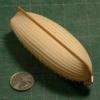-
Posts
13,302 -
Joined
-
Last visited
Content Type
Profiles
Forums
Gallery
Events
Everything posted by druxey
-
I recently finished Dead Wake. As mentioned, it is very readable and well researched. It amazed me that, had one of many factors been slightly different, the sinking might well have been avoided. And, before reading this volume, I knew nothing about Room 40, the WWI equivalent of Bletchley Park. Highly recommended. Thanks you for bringing this book to our attention, Allan.
-
Nice concept. Looking forward to progress reports!
- 30 replies
-
- philadelphia
- diorama
-
(and 3 more)
Tagged with:
-
That is a major modification! Nicely and neatly done, Mike.
- 968 replies
-
- hahn
- oliver cromwell
-
(and 1 more)
Tagged with:
-
Jokes about early manuscripts aside, there is a wonderful tutorial on the National Archives (U.K.) site that will teach you how to read different manuscript 'hands'. The examples they give you go from easy to progressively more difficult. You 'translate' these samples and then check against their transcription for feedback. Also, if you go back far enough, official manuscripts were in Latin. There is also a great 'teach yourself Latin' course on the same web site. I highly recommend both. Warning: the learning to read manuscript instructional course is addictive!
- 19 replies
-
- Early Navy
- frigates
-
(and 2 more)
Tagged with:
-
Well that looks like a fun project. Still easier than transcribing/translating mediaeval documents!
- 19 replies
-
- Early Navy
- frigates
-
(and 2 more)
Tagged with:
-
Coming along nicely. I found turning in deadeyes consistently easier off-model. First I mark them while in position, then remove them to turn in the deadeyes, then replace them. However, looks like you nailed them anyway!
- 452 replies
-
- cheerful
- Syren Ship Model Company
-
(and 1 more)
Tagged with:
-
Well done, Kevin. This is the 'marathon' part of the model completed. The rest of the work will have much more variety!
- 1,126 replies
-
Your experiments look very effective, Daniel. Try using acrylic paint with a ruling pen to get the seam doubling with less transparency and see what you think. I've used this very effectively at a much larger scale (1:48) on SilkSpan. One needs to pre-stretch any paper as one would for watercolor paper to avoid sags and wrinkles when wetted. Also, Silkspan won't tear when wet.
-
So nice to see you back and the terrific progress you are making. Interesting shellac/silk technique that you've used, Glenn.
-

ancre Le Fleuron by juzek - 1:27
druxey replied to juzek's topic in - Build logs for subjects built 1501 - 1750
You are moving along there! Looking excellent, Juzek. -
A Forstner drill bit will give smoother cuts, I think.
- 2,625 replies
-
- kaiser wilhelm der grosse
- passenger steamer
-
(and 1 more)
Tagged with:
-
For some reason I've only just stumbled across your log. Very neat work indeed. Please assume a 'like' has been added to every progress report!
- 277 replies
-
- model shipways
- 18th century longboat
-
(and 1 more)
Tagged with:
-
I can only hope that the various forces tending towards warping cancel each other out. If not, you'll have a gondola!
-
Thanks, Wefalck, for your description of Pertinax. All I could find was the Roman emperor of that name!
-
What is Pertinax made of, please? Looks like an interesting and useful material. Nice work!
About us
Modelshipworld - Advancing Ship Modeling through Research
SSL Secured
Your security is important for us so this Website is SSL-Secured
NRG Mailing Address
Nautical Research Guild
237 South Lincoln Street
Westmont IL, 60559-1917
Model Ship World ® and the MSW logo are Registered Trademarks, and belong to the Nautical Research Guild (United States Patent and Trademark Office: No. 6,929,264 & No. 6,929,274, registered Dec. 20, 2022)
Helpful Links
About the NRG
If you enjoy building ship models that are historically accurate as well as beautiful, then The Nautical Research Guild (NRG) is just right for you.
The Guild is a non-profit educational organization whose mission is to “Advance Ship Modeling Through Research”. We provide support to our members in their efforts to raise the quality of their model ships.
The Nautical Research Guild has published our world-renowned quarterly magazine, The Nautical Research Journal, since 1955. The pages of the Journal are full of articles by accomplished ship modelers who show you how they create those exquisite details on their models, and by maritime historians who show you the correct details to build. The Journal is available in both print and digital editions. Go to the NRG web site (www.thenrg.org) to download a complimentary digital copy of the Journal. The NRG also publishes plan sets, books and compilations of back issues of the Journal and the former Ships in Scale and Model Ship Builder magazines.


